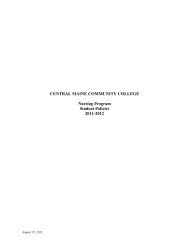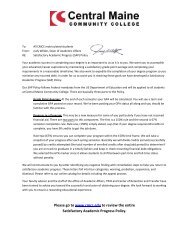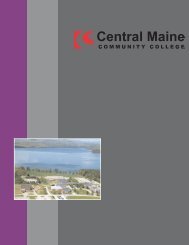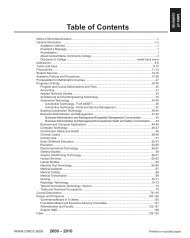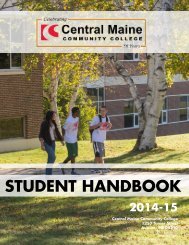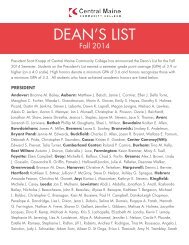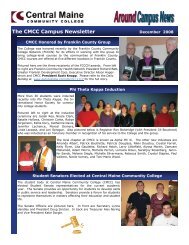Academic Policies and Procedures - Central Maine Community ...
Academic Policies and Procedures - Central Maine Community ...
Academic Policies and Procedures - Central Maine Community ...
Create successful ePaper yourself
Turn your PDF publications into a flip-book with our unique Google optimized e-Paper software.
Course Descriptions<br />
course<br />
descriptions<br />
for the measurement <strong>and</strong> control of process<br />
variables. Particular emphasis is placed on the<br />
theory <strong>and</strong> appli cation of pressure, flow, level,<br />
<strong>and</strong> tempera ture measurements. Processes<br />
will be analyzed in terms of process dead time<br />
<strong>and</strong> capacity to determine optimum loop turning<br />
parameters. Selected labs using Foxboro instrumentation<br />
will be used throughout to create real<br />
<strong>and</strong> simulated process control systems. Prerequisite:<br />
ELT 112.<br />
ELT 123 Electrical Controls I<br />
3 Credits (2 lecture 1 Lab 0 Shop)<br />
4 Hrs/Wk (2 Hrs. Lecture 2 Hrs. Lab) *15 wks<br />
This course is a study of the functioning of electrical<br />
devices that are primarily used for manual<br />
switching of circuits such as piloted single-pole<br />
switches, Eagle three-way switches, four-way<br />
switches, momentary relays, <strong>and</strong> latching relays.<br />
Emphasis is placed on methods of wiring<br />
these devices into a system following N.E.C.<br />
procedures <strong>and</strong> interpreting blueprints <strong>and</strong><br />
schematics. Applications include wiring switches<br />
to con trol lights <strong>and</strong> receptacles. Complete<br />
switching systems are formed by wiring together<br />
electrical equipment such as time-clocks, photoeyes,<br />
<strong>and</strong> relays. Single-phase transformers<br />
are used to step-up, step-down, <strong>and</strong> buck/boost<br />
voltages. DC motors are tested <strong>and</strong> connected<br />
for spe cifi c direction of rotation <strong>and</strong> speed. Corequisite:<br />
ELT 111.<br />
ELT 126 Electrical Controls II<br />
2 Credits (1 Lecture 1 Lab 0 Shop)<br />
3 Hrs/Wk (1 Hr. Lecture 2 Hrs. Lab) *15 wks<br />
This course is a study of basic control concepts<br />
<strong>and</strong> their applications to automat ed systems.<br />
This includes: single <strong>and</strong> three phase motors,<br />
manual <strong>and</strong> magnetic motor starters, push button<br />
circuits, <strong>and</strong> oil burner controls. Particular<br />
emphasis is on: three phase principles <strong>and</strong> calculations,<br />
single & 3 phase motor connections,<br />
basic motor <strong>and</strong> heating control circuits <strong>and</strong><br />
article 430 of the NEC. Interpreting blueprints<br />
<strong>and</strong> schematics. Applications include: testing 3<br />
phase motors <strong>and</strong> connecting them to basic motor<br />
control circuits. Testing <strong>and</strong> troubleshooting<br />
single phase motors. Connecting <strong>and</strong> troubleshooting<br />
oil burner control circuits. Interpreting<br />
motor control catalogs. Prerequisite: ELT 123.<br />
ELT 145 Electronic Devices I<br />
3 Credits (2 lecture 1 Lab 0 Shop)<br />
4 Hrs/Wk (2 Hrs. Lecture 2 Hrs. Lab) *15 wks<br />
This fi rst course in analog electronics is a study<br />
of semiconductor theory, PN diodes, <strong>and</strong> Bipolar<br />
transistors. These devices are analyzed by the<br />
use of ‘r’ parameters, Load-Line analysis, <strong>and</strong><br />
the Ebers-Moll Model. Equivalent circuits are<br />
derived using Thevenin’s <strong>and</strong> Nortons’s theorems.<br />
Particular emphasis is placed on I/V characteristics,<br />
methods of biasing, <strong>and</strong> selec tion of<br />
replacement devices. Diode applications include<br />
filtered rectifiers, lim iters, clampers, <strong>and</strong> Zener<br />
voltage regula tion. Bipolar transistor applications<br />
include current sources, transistor switch,<br />
<strong>and</strong> the CE amplifier. Co-requisite: ELT 112.<br />
ELT 153 Digital Logic<br />
3 Credits (2 lecture 1 Lab 0 Shop)<br />
4 Hrs/Wk (2 Hrs. Lecture 2 Hrs. Lab) *15 wks<br />
This course is a study of the basic princi ples of<br />
TTL integrated circuits, <strong>and</strong> their applications in<br />
digital systems. This includes the use of logic<br />
gates, flip-flops, counters, shift registers, decoders,<br />
multi plexers <strong>and</strong> demultiplexers. In addition,<br />
we will cover IC terminology, specifications,<br />
circuits <strong>and</strong> troubleshooting. Other logic families<br />
besides TTL will be introduced. Electronic Workbench<br />
will be used for Boolean algebra <strong>and</strong> to<br />
simulate circuits. There will be an introduction to<br />
the use of oscilloscopes for the purpose of testing<br />
<strong>and</strong> troubleshooting. Co-requisite: ELT 111.<br />
ELT 211 Control Systems<br />
3 Credits (2 lecture 1 Lab 0 Shop)<br />
4 Hrs/Wk (2 Hrs. Lecture 2 Hrs. Lab) *15 wks<br />
This course is designed to provide an introduction<br />
to motors, industrial controls <strong>and</strong> programmable<br />
controllers. Full voltage <strong>and</strong> IEC<br />
magnetic starters <strong>and</strong> overload units are selected<br />
for a particular motor accord ing to NEC<br />
guidelines. Applications include: Stop-Start,<br />
jog, forward-reverse, <strong>and</strong> timer circuits. Ladder,<br />
wiring <strong>and</strong> PLC diagrams are generated. The<br />
Allen-Bradley SLC-500 family line of programmable<br />
con troller is used. Instruction, hardware,<br />
<strong>and</strong> programming of PLC are examined. Particular<br />
emphasis placed on wiring circuits <strong>and</strong><br />
their applications to programmable controllers.<br />
Co-requisites: ELT 112 <strong>and</strong> 153.<br />
ELT 221 Industrial Controls<br />
3 Credits (2 lecture 1 Lab 0 Shop)<br />
4 Hrs/Wk (2 Hrs. Lecture 2 Hrs. Lab) *15 wks<br />
This course is a study of electro-magnetic controls,<br />
their applications in automated industrial<br />
systems <strong>and</strong> how to interface them with intelligent<br />
controllers. This includes the usage of<br />
I.E.C. <strong>and</strong> NEMA magnetic starters, overload<br />
heater selec tion, push button, timers, counters,<br />
<strong>and</strong> intelligent controllers. Particular emphasis is<br />
placed on ladder diagrams, designing <strong>and</strong> wiring<br />
control circuits, article 430 of the NEC, programming<br />
of an AC frequency Drive. Three phase<br />
distributors <strong>and</strong> three phase motors are also<br />
covered. Prerequi sites: ELT 112, 123, <strong>and</strong> 153.<br />
ELT 222 Programmable Controls<br />
3 Credits (2 lecture 1 Lab 0 Shop)<br />
4 Hrs/Wk (2 Hrs. Lecture 2 Hrs. Lab) *15 wks<br />
This course is a study of Programmable Logic<br />
Controllers (PLCs), which monitor electrical<br />
inputs <strong>and</strong> in turn controls outputs to automate<br />
a process or machine. Partic ular emphasis is<br />
placed on ladder logic pro gramming. Programs<br />
are created using PLC instructions that are<br />
categorized by function: Relay logic, timers,<br />
counters, data-manipulation, arithmetic, datacom<br />
parison, data-transfer, <strong>and</strong> program control.<br />
Students set up hardware addressing on PLC<br />
racks/modules <strong>and</strong> verify physical wiring of realworld<br />
devices. They establish communications<br />
between a computer <strong>and</strong> a PLC processor using<br />
Rockwell’s RSLinx software. Ladder logic<br />
programs are written for Allen Bradley’s PLC5<br />
programmable controller using RSLogix5 software.<br />
Appli cation includes the control of electric<br />
motors <strong>and</strong> industrial control circuits. Advanced<br />
topics include remote I/O communications <strong>and</strong><br />
analog output control of AC frequency drives.<br />
Prerequisite: ELT 221.<br />
ELT 231 Process Measurement<br />
3 Credits (2 lecture 1 Lab 0 Shop)<br />
4 Hrs/Wk (2 Hrs. Lecture 2 Hrs. Lab) *15 wks<br />
This course is designed to prepare the stu dent<br />
in the areas of logical analysis, trouble shooting<br />
technique, maintenance, <strong>and</strong> selection of industrial<br />
primary devices <strong>and</strong> transmitters used<br />
for the measurement <strong>and</strong> control of process<br />
variables. The selection, sizing, <strong>and</strong> calibration<br />
of devices for meas uring steam, liquid <strong>and</strong> gas<br />
flows will be introduced to the student in class<br />
<strong>and</strong> lab. Particular emphasis is placed on the<br />
theory <strong>and</strong> application of pressure, fl ow, level,<br />
den sity, humidity, <strong>and</strong> temperature measurements.<br />
Prerequisites: ELT 112 <strong>and</strong> 145.<br />
ELT 232 Process Control<br />
3 Credits (2 lecture 1 Lab 0 Shop)<br />
4 Hrs/Wk (2 Hrs. Lecture 2 Hrs. Lab) *15 wks<br />
This course is a continuation of Process Measurement<br />
<strong>and</strong> explores the character istics of<br />
common feedback control loops, mechanisms,<br />
www.cmcc.edu 2010 ~ 2011 95





